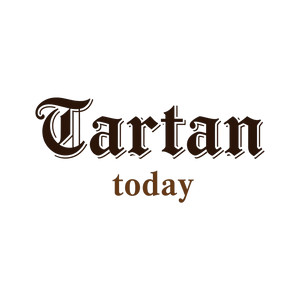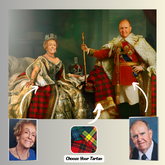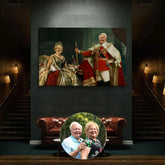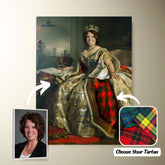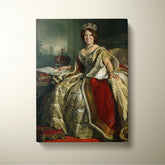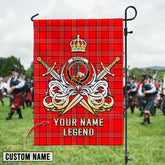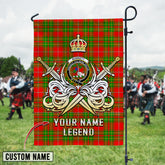-
Clan Burnett Tartan Unisex Baseball Jersey NV15DI31 - Burnett Tartan
Burnett Tartan Clan Unisex Baseball Jersey NV15DI31 Product Detail: Each of our baseball jerseys is custom-made-to-order and handcrafted to the highest quality standards. It is not only extremely soft to the touch but breathable as well. Our jersey is printed on sustainable fabrics so...- $42.25 USD
- $42.25 USD
- Unit price
- per
-
Burnett Tartan
-
Personalized Clan Burnett Modern Tartan Bagpipe Ornament with Custom Name – Scottish Christmas Tree Decoration DH83
Personalized Clan Burnett Modern Tartan Bagpipe Ornament with Custom Name – Scottish Christmas Tree Decoration DH83Celebrate your Scottish heritage with this unique wood & acrylic tartan ornament. Perfect as a personalized Christmas decoration or a meaningful gift for friends and relatives on special occasions...- From $19.99 USD
$25.99 USD- From $19.99 USD
- Unit price
- per
Save $6.00 -
Clan Burnett Tartan Crest Christmas Stocking YF17 - Burnett Tartan
Clan Burnett Tartan Crest Christmas Stocking YF17 DESCRIPTION: Christmas Stocking is used to display as home decoration or meaningful gifts for friends and relatives on special occasions such as Christmas, Valentine, birthday' Dimensions: (Cuff Width x Length x Width): 20 x 40 x 28...- $24.45 USD
- $24.45 USD
- Unit price
- per
-
Burnett Tartan
-
Personalized Clan Burnett Ancient Tartan Bagpipe Ornament with Custom Name – Scottish Christmas Tree Decoration CY50
Personalized Clan Burnett Ancient Tartan Bagpipe Ornament with Custom Name – Scottish Christmas Tree Decoration CY50Celebrate your Scottish heritage with this unique wood & acrylic tartan ornament. Perfect as a personalized Christmas decoration or a meaningful gift for friends and relatives on special occasions...- From $19.99 USD
$25.99 USD- From $19.99 USD
- Unit price
- per
Save $6.00 -
Personalized Clan Burnett Hunting Modern Tartan Santa Ornament – Custom Acrylic Christmas Decoration EI52 - Burnett
Personalized Clan Burnett Hunting Modern Tartan Ornament – Custom Acrylic Christmas Decoration EI52Celebrate your Scottish heritage with this unique wood & acrylic tartan ornament. Perfect as a personalized Christmas decoration or a meaningful gift for friends and relatives on special occasions such as Christmas,...- From $19.99 USD
- From $19.99 USD
- Unit price
- per
-
Burnett
-
Personalized Clan Burnett Weathered Clan Crest Tartan Santa Ornament – Custom Acrylic Christmas Decoration FD30 - Burnett
Personalized Clan Burnett Weathered Clan Badge Tartan Ornament – Custom Acrylic Christmas Decoration FD30Celebrate your Scottish heritage with this unique wood & acrylic tartan ornament. Perfect as a personalized Christmas decoration or a meaningful gift for friends and relatives on special occasions such as...- From $19.99 USD
- From $19.99 USD
- Unit price
- per
-
Burnett
-
Personalized Clan Burnett Modern Clan Crest Tartan Santa Ornament – Custom Acrylic Christmas Decoration TZ91 - Burnett
Personalized Clan Burnett Modern Clan Badge Tartan Ornament – Custom Acrylic Christmas Decoration TZ91Celebrate your Scottish heritage with this unique wood & acrylic tartan ornament. Perfect as a personalized Christmas decoration or a meaningful gift for friends and relatives on special occasions such as...- From $19.99 USD
- From $19.99 USD
- Unit price
- per
-
Burnett
-
Personalized Clan Burnett of Powis Ancient Clan Crest Tartan Santa Ornament – Custom Acrylic Christmas Decoration SN25 - Burnett
Personalized Clan Burnett of Powis Ancient Clan Badge Tartan Ornament – Custom Acrylic Christmas Decoration SN25Celebrate your Scottish heritage with this unique wood & acrylic tartan ornament. Perfect as a personalized Christmas decoration or a meaningful gift for friends and relatives on special occasions...- From $19.99 USD
- From $19.99 USD
- Unit price
- per
-
Burnett
-
Personalized Clan Burnett of Leys Ancient Clan Crest Tartan Santa Ornament – Custom Acrylic Christmas Decoration NT73 - Burnett
Personalized Clan Burnett of Leys Ancient Clan Badge Tartan Ornament – Custom Acrylic Christmas Decoration NT73Celebrate your Scottish heritage with this unique wood & acrylic tartan ornament. Perfect as a personalized Christmas decoration or a meaningful gift for friends and relatives on special occasions...- From $19.99 USD
- From $19.99 USD
- Unit price
- per
-
Burnett
-
Personalized Clan Burnett of Leys Modern Clan Crest Tartan Santa Ornament – Custom Acrylic Christmas Decoration AN39 - Burnett
Personalized Clan Burnett of Leys Modern Clan Badge Tartan Ornament – Custom Acrylic Christmas Decoration AN39Celebrate your Scottish heritage with this unique wood & acrylic tartan ornament. Perfect as a personalized Christmas decoration or a meaningful gift for friends and relatives on special occasions...- From $19.99 USD
- From $19.99 USD
- Unit price
- per
-
Burnett
-
Personalized Clan Burnett of Leys Ancient Clan Crest Tartan Santa Ornament – Custom Acrylic Christmas Decoration RJ81 - Burnett
Personalized Clan Burnett of Leys Ancient Clan Badge Tartan Ornament – Custom Acrylic Christmas Decoration RJ81Celebrate your Scottish heritage with this unique wood & acrylic tartan ornament. Perfect as a personalized Christmas decoration or a meaningful gift for friends and relatives on special occasions...- From $19.99 USD
- From $19.99 USD
- Unit price
- per
-
Burnett
-
Personalized Clan Burnett of Leys Modern Clan Crest Tartan Santa Ornament – Custom Acrylic Christmas Decoration GW74 - Burnett
Personalized Clan Burnett of Leys Modern Clan Badge Tartan Ornament – Custom Acrylic Christmas Decoration GW74Celebrate your Scottish heritage with this unique wood & acrylic tartan ornament. Perfect as a personalized Christmas decoration or a meaningful gift for friends and relatives on special occasions...- From $19.99 USD
- From $19.99 USD
- Unit price
- per
-
Burnett
-
Personalized Clan Burnett Ancient Clan Crest Tartan Santa Ornament – Custom Acrylic Christmas Decoration PE30 - Burnett
Personalized Clan Burnett Ancient Clan Badge Tartan Ornament – Custom Acrylic Christmas Decoration PE30Celebrate your Scottish heritage with this unique wood & acrylic tartan ornament. Perfect as a personalized Christmas decoration or a meaningful gift for friends and relatives on special occasions such as...- From $19.99 USD
- From $19.99 USD
- Unit price
- per
-
Burnett
-
Personalized Clan Burnett Weathered Clan Crest Tartan Santa Ornament – Custom Acrylic Christmas Decoration MU49 - Burnett
Personalized Clan Burnett Weathered Clan Badge Tartan Ornament – Custom Acrylic Christmas Decoration MU49Celebrate your Scottish heritage with this unique wood & acrylic tartan ornament. Perfect as a personalized Christmas decoration or a meaningful gift for friends and relatives on special occasions such as...- From $19.99 USD
- From $19.99 USD
- Unit price
- per
-
Burnett
-
Personalized Clan Burnett Hunting Ancient Tartan Santa Ornament – Custom Acrylic Christmas Decoration AP64 - Burnett
Personalized Clan Burnett Hunting Ancient Tartan Ornament – Custom Acrylic Christmas Decoration AP64Celebrate your Scottish heritage with this unique wood & acrylic tartan ornament. Perfect as a personalized Christmas decoration or a meaningful gift for friends and relatives on special occasions such as Christmas,...- From $19.99 USD
- From $19.99 USD
- Unit price
- per
-
Burnett
-
Clan Burnett Ancient Tartan Crest Rug – Scottish Highland Carpet for Living Room, Celtic Home Decor & Scotland Gift GU21
Clan Burnett Ancient Tartan Crest Rug – Scottish Highland Carpet for Living Room, Celtic Home Decor & Scotland Gift GU21Bring timeless Scottish charm into your home with our premium Tartan Area Rug. Designed with authentic Scottish tartan patterns, this rug is perfect for adding...- From $58.45 USD
- From $58.45 USD
- Unit price
- per
-
Clan Burnett Ancient Tartan Rug – Scottish Highland Carpet for Living Room, Celtic Home Decor & Scotland Gift NR17
Clan Burnett Ancient Tartan Rug – Scottish Highland Carpet for Living Room, Celtic Home Decor & Scotland Gift NR17Bring timeless Scottish charm into your home with our premium Tartan Area Rug. Designed with authentic Scottish tartan patterns, this rug is perfect for adding a...- From $58.45 USD
- From $58.45 USD
- Unit price
- per
-
Clan Burnett Modern Tartan Rug – Scottish Highland Carpet for Living Room, Celtic Home Decor & Scotland Gift EH70
Clan Burnett Modern Tartan Rug – Scottish Highland Carpet for Living Room, Celtic Home Decor & Scotland Gift EH70Bring timeless Scottish charm into your home with our premium Tartan Area Rug. Designed with authentic Scottish tartan patterns, this rug is perfect for adding a...- From $58.45 USD
- From $58.45 USD
- Unit price
- per
-
Custom Name Clan Burnett Modern Tartan Garden Flag with Clan Crest and the Golden Sword of Courageous Legacy AM64 - Burnett Modern
Custom Name Clan Burnett Modern Tartan Garden Flag with Clan Crest and the Golden Sword of Courageous Legacy AM64 Immerse your space in the rich heritage of Scotland with our Tartan Garden Flags, exclusively from Tartan Today. Featuring vibrant tartan and Scottish heritage designs, these...- From $34.45 USD
- From $34.45 USD
- Unit price
- per
-
Burnett Modern
-
Custom Name Clan Burnett Ancient Tartan Garden Flag with Clan Crest and the Golden Sword of Courageous Legacy XE12 - Burnett Ancient
Custom Name Clan Burnett Ancient Tartan Garden Flag with Clan Crest and the Golden Sword of Courageous Legacy XE12 Immerse your space in the rich heritage of Scotland with our Tartan Garden Flags, exclusively from Tartan Today. Featuring vibrant tartan and Scottish heritage designs, these...- From $34.45 USD
- From $34.45 USD
- Unit price
- per
-
Burnett Ancient
Ex: Your Tartan + Product
Popular Products
Turn Me Royal Personalized Portrait from Your Photo, Custom Tartan. Custom Canvas Wall Art as Gift for Men
- From $32.45 USD
- From $32.45 USD
- Unit price
- / per
Royalty Couple Personalized Portrait from Your Photo, Custom Tartan. Custom Canvas Wall Art
- From $47.45 USD
- From $47.45 USD
- Unit price
- / per
The Queen Personalized Portrait from Your Photo, Custom Tartan. Custom Canvas Wall Art as Gift for Women
- From $32.45 USD
- From $32.45 USD
- Unit price
- / per
Which Clan Are You From?
- Apron
- Burnett
- Burnett Ancient
- Burnett Ancient Gnome
- Burnett Ancient Tartan
- Burnett Hunting Ancient
- Burnett Hunting Modern
- Burnett Modern
- Burnett Modern Gnome
- Burnett Modern Tartan
- Burnett of Leys
- Burnett of Leys Ancient
- Burnett of Leys Hunting
- Burnett of Leys Modern
- Burnett of Leys Weathered
- Burnett of Powis Ancient
- Burnett of Powis Modern
- Burnett of Powis Weathered
- Burnett Tartan
- Burnett Tartan Clan
- Burnett Weathered
- Scott
List Of Tartan
-
Clan A
- Abercrombie Tartan
- Aberdeen Tartan
- Abernethy Tartan
- Adair Tartan
- Adam Tartan
- Ayrshire Tartan
- Agnew Tartan
- Aikenhead Tartan
- Ainslie Tartan
- Aiton Tartan
- Allan Tartan
- Alexander Tartan
- Allardice Tartan
- Allison Tartan
- Anderson Tartan
- Angus Tartan
- Anstruther Tartan
- Arbuthnot Tartan
- Armstrong Tartan
- Arnott Tartan
- Auchinleck Tartan
- Ayrshire Tartan
-
Clan B
- Baillie Tartan
- Bain Tartan
- Baird Tartan
- Balfour Tartan
- Bannatyne Tartan
- Bannerman Tartan
- Barclay Tartan
- Baxter Tartan
- Beaton Tartan
- Bell Tartan
- Belshes Tartan
- Bethune Tartan
- Beveridge Tartan
- Binning Tartan
- Bisset Tartan
- Blackadder Tartan
- Blackstock Tartan
- Black Watch Tartan
- Blair Tartan
- Blane Tartan
- Blyth Tartan
- Borthwick Tartan
- Boswell Tartan
- Bowie Tartan
- Boyd Tartan
- Boyle Tartan
- Brisbane Tartan
- Brodie Tartan
- Brown/ Broun Tartan
- Bruce Tartan
- Buccleuch Tartan
- Buchan Tartan
- Buchanan Tartan
- Burnett Tartan
- Burns Tartan
- Butter Tartan
- Byres Tartan
-
Clan C
- Cairns Tartan
- Calder Tartan
- Callander Tartan
- Cameron Tartan
- Campbell Tartan
- Campbell of Breadalbane Tartan
- Campbell of Cawdor Tartan
- Carmichael Tartan
- Carnegie Tartan
- Carruthers Tartan
- Cathcart Tartan
- Chalmers Tartan
- Charteris Tartan
- Chattan Tartan
- Cheyne Tartan
- Chisholm Tartan
- Christie Tartan
- Clark Tartan
- Clelland Tartan
- Clephan Tartan
- Clergy Tartan
- Cochrane Tartan
- Cockburn Tartan
- Colquhoun Tartan
- Colville Tartan
- Cooper Tartan
- Couper Tartan
- Craig Tartan
- Cranstoun Tartan
- Crawford Tartan
- Crichton Tartan
- Crief District Tartan
- Crosbie Tartan
- Cumming Tartan
- Cunningham Tartan
- Currie Tartan
- Clan D
- Clan E
- Clan F
- Clan G
- Clan H
- Clan I
- Clan J
- Clan K
- Clan L
-
Clan M
- Maitland Tartan
- Malcolm Tartan
- Mar Tartan
- Marjoribanks Tartan
- Maxtone Tartan
- Matheson Tartan
- Maule Tartan
- Maxwell Tartan
- Meldrum Tartan
- Melville Tartan
- Menzies Tartan
- Mercer Tartan
- Middleton Tartan
- Moffat Tartan
- Moncrieffe Tartan
- Montgomery Tartan
- Monypenny Tartan
- Moncreiffe Tartan
- Monteith Tartan
- Morrison Tartan
- Mouat Tartan
- Moubray Tartan
- Mow Tartan
- Muir_More Tartan
- Muirhead Tartan
- Munro Tartan
- Murray Tartan
- Murray of Atholl Tartan
-
Clan Mc/Mac
- MacAlister Tartan
- MacArthur Tartan
- MacAlpine Tartan
- MacAulay Tartan
- MacBain Tartan
- MacBean Tartan
- MacBeth Tartan
- MacCallum Tartan
- MacCraig Tartan
- MacColl Tartan
- MacCorquodale Tartan
- MacDiarmid Tartan
- MacDonald Tartan
- MacDonald of Clanranald Tartan
- MacDonald of Sleat Tartan
- MacDonnell of Glengarry Tartan
- MacDonnell of Keppoch Tartan
- MacDougall Tartan
- MacDowall Tartan
- MacDuff Tartan
- MacEwen_MacEwan Tartan
- MacEdward Tartan
- MacFarlane Tartan
- MacGill Tartan
- MacGillivray Tartan
- MacGregor Tartan
- MacGowan (McGowan) Tartan
- MacHardy Tartan
- MacIan Tartan
- MacInnes Tartan
- MacIntyre Tartan
- MacKay Tartan
- MacKillop Tartan
- MacKellar Tartan
- Mackinlay Tartan
- MacKenzie Tartan
- Mackie Tartan
- MacKinnon Tartan
- MacKintosh / MacIntosh Tartan
- MacLeod Tartan
- MacMillan Tartan
- MacNab Tartan
- MacNaughton Tartan
- MacNeil / MacNeill Tartan
- MacNeil of Colonsay Tartan
- MacNicol Tartan
- MacPhail Tartan
- MacPhee_MacFie Tartan
- MacPherson Tartan
- MacQuarrie Tartan
- MacQueen Tartan
- MacRae Tartan
- MacRow Tartan
- MacSporran Tartan
- MacTaggart Tartan
- MacTavish Tartan
- MacThomas Tartan
- McCorquodale Tartan
- McCulloch Tartan
- McFadzen Tartan
- McGeachie Tartan
- McIver Tartan
- McKerrell Tartan
- Clan N
- Clan O
- Clan P
- Clan R
-
Clan S
- Sandilands Tartan
- Scott Tartan
- Scrymgeour Tartan
- Selkirk Tartan
- Sempill Tartan
- Seton Tartan
- Shaw Tartan
- Shepherd Tartan
- Sinclair Tartan
- Skene Tartan
- Skirving Tartan
- Smith Tartan
- Somerville Tartan
- Spalding Tartan
- Spens Tartan
- Spottiswood Tartan
- Stevenson Tartan
- Stewart Tartan
- Stewart of Appin Tartan
- Stirling Tartan
- Strachan Tartan
- Straiton Tartan
- Strange Tartan
- Strathclyde District Tartan
- Stuart of Bute Tartan
- Sutherland Tartan
- Swinton Tartan
- Clan T
- Clan U W Y
- Request Your Clan
Clan Burnett (Burnett Tartan)
1. About Clan Burnett (Burnett Tartan)
2. Clan Burnett History (Burnett Tartan)
Even while it has been claimed that the family is descended from the Normans, it is more likely that the surname Burnett is a form of Burnard, which is derived from the Old English character Beornheard, who lived in England before to 1066. Beornheard, which is Saxon for "bear hand," is also occasionally translated as "brave warrior."
The de Bernard family, who arrived to Scotland in the 12th century on David I's retinue, initially made their home in the south, where some of them persisted and became the Burnetts of Barns.
The main branch moved to Kincardineshire and established themselves as the Burnetts of Leys.
Alexander Burnett, who backed Robert the Bruce, was given a plot of land in the regal Forest of Drum and the position of forester.
The "Horn of Leys," an ivory horn that hangs in the main hall of Crathes Castle, is said to have been given by Bruce as a sign of this. Robert, his great-grandson, received the initial "of Leys" designation in 1446.
The Burnett family's connection with the church has been rocky; yet, they are known to have granted estates and endowments in the fifteenth century.
Later, Burnett invited the local priest Father Ambrose to participate in discussions in a land dispute between himself and the neighbouring Laird of Drum, but he declined.
Infuriated, Burnett forbade the local monks from fishing in the Loch of Leys. Burnett and the monks who cursed him became angry as a result of this.
He then made an attempt to drain the loch, but his son was killed in the process, and following the tragedy, the two sides were amicable.
The Crathes Castle, built in 1533 in Kincardineshire to the north of the Dee, serves as the clan's administrative center. Construction of the castle, which is still L-shaped, took 40 years. The ghost of Crathes Castle is also said to exist.
The ghost is thought to be Bertha de Bernard, a Burnett family relation who is said to have been poisoned (some claim by Lady Agnes Burnett) after falling in love with one of her engaged cousins.
According to legend, Bertha's father cursed the family, and until the 17th century, a 'Green Lady' was reportedly seen in the castle as a sign of bad omens for the home.
Charles I appointed Sir Thomas Burnett a Baronet of Nova Scotia in 1626. He was the Marquis of Montrose's acquaintance and relative, and he also backed the Covenant.
His son was one of the few Scottish parliamentarians to reject the 1707 Act of Union, serving in the previous Scottish parliament.
Sir Robert Burnett of Leys left no heirs when he died, and the title was severely fought for seven years before it finally passed to Thomas Burnett of Criggie.
During the American Wars, the seventh Baronet served in the Royal Scots Fusiliers and was captured at Saratoga in 1777. In the First World War, a Gordon Highlanders brigade was headed by Major General Sir James Burnett of Leys, twelfth Baronet.
He received many mentions in dispatches and twice received the DSO and the French Legion of Honor. The current chief is his grandson, who continues to reside on the family's grounds.
3. Clan Burnett Tartans
The Burnett is a relatively new tartan that Lochcarron created.
'Ancient' refers to the dye colours, which are often lighter, and'modern' refers to the darker dye shades.
Threadcount R58 G6 R8 G28 Y6 G28 R/8 A/8 R58
Burnett Ancient
Burnett Modern
Burnett of Leys
4. Clan Burnett Crest & Coats of Arms
4.1 Clan Burnett Crest
Worn by all of the name and ancestry
4.2 Clan Burnett Coat of Arms
Note on Coats of Arms: A coat of arms is given to an individual under Scottish heraldic law (with the exception of civic or corporate arms). A 'family coat of arms' does not exist.
With the exclusions listed above, the weapons depicted below are personal weapons. The only person authorized to use these weapons is the grantee.
Coat of arms of the Chief, James C. A. Burnett of Leys
Burnett of Leys
Charles John Burnett H.M. Ross Herald of Arms
Arms: each chevron A holly leaf between two quills and a contourné-stringed hunting horn are displayed in the center of an azure and argent field, all counterchanged.
Crest: A demi angel wearing armor with displayed wings and a collar with a fringed pendant is presented. A quill is held in each of Azure's hands. Azure
Motto: FORWARD WHILE LOOKING BACK
Grant: March 10, 1982. 75th folio, 63rd volume, Lyon Register.
Behind the shield are the crossed batons of a Herald, the cross of a Knight of Justice of the Most Venerable Order of the Hospital of St. John of Jerusalem, and a Collar of Esses.
5. Clan Burnett Places & People
5.1 Clan Burnett Places
The ancestral home of the Burnett family, Crathes Castle in Aberdeenshire, was founded on grounds given to the Burnett of Leys by Robert the Bruce in 1323. Alexander Burnett of Leys started building the existing castle in 1553 and finished it in 1596.
Over the course of four decades, there were numerous delays, primarily because of political difficulties under Mary, Queen of Scots' stormy rule.
These territories had previously been home to timber fortifications from the 13th and 14th centuries before the stone fortress was built there.
After nearly 400 years in the ownership of the Burnett family, Sir James Burnett, 13th Baronet, sold Crathes Castle to the National Trust for Scotland in 1951. Visitors are welcome at the Crathes Castle Estate.
5.2 Clan Burnett People
Gilbert Burnet (1643 – 1715)
Bishop of Salisbury, Scottish theologian, and historian. He was fluent in Latin, Greek, Hebrew, Dutch, and French. Gilbert was well-known as a writer, historian, and academic in addition to being a revered cleric, preacher, and professor.
In 1643, he was born in Edinburgh, Scotland, the son of a Royalist and Episcopalian lawyer who later became a judge and of Johnston of Warristoun, a prominent Covenanter.
When he first started attending the University of Aberdeen, his father served as his first tutor. At the age of thirteen, he graduated with a Master of Arts in philosophy from the university.
He briefly studied law before deciding to pursue religion, and by the age of 18, he had received his Doctor of Divinity. He spent a number of years traveling instead of starting his ministry at that time.
He traveled to the United Provinces, France, London, Oxford, Cambridge, and Cambridge. In Amsterdam, he pursued Hebrew study under a Rabbi. By 1665, he had returned to Scotland, where the Bishop of Edinburgh had ordained him.
He started his ministry in the small church in Saltoun, East Lothian, and devotedly served this area for four years. Without his request or his approval, he was appointed to the open Divinity chair at the University of Glasgow in 1669.
His church had overwhelmingly begged him to stay, so at first he declined. But he agreed to the position after being persuaded by Bishop of Edinburgh Leighton.
In 1674, he left the university and relocated to London due to the unrest in the political climate. His political and religious beliefs in London led him to support the Whigs.
His vivacious personality encouraged him to participate actively in the debates of the day and he made an effort to mediate a settlement between the Episcopacy and Presbytery.
He was well liked by Charles II when he left for London and obtained a number of preferments from him.
The first volume of his History of the Reformation of the Church of England, for which he gained praise from the English Parliament, was published in 1679, and the remaining two volumes, published in 1682 and 1714, substantially improved his literary reputation.
Although Catholics contested some of its content, for more than a century this served as the industry standard reference work.
He lost favor at Court as a result of a letter of rebuke he dared to write to the King, and since he found James II's policies to be deeply distasteful, he decided to leave for the United Provinces in 1687, where he joined the Prince of Orange's council.
Upon his return to the Kingdom of England, he was appointed Bishop of Salisbury, an office he graced with liberal beliefs and a vigorous performance of his duties.
He ordered that History of My Own Times not be published until six years after his passing. This work is the main source of his reputation. 1723 saw its debut.
A brief overview of the Civil War and the Commonwealth of England's history is provided, along with a thorough examination of the years immediately following, up to 1713.
It is written with a true aim for honesty and fairness, albeit it is not entirely free of egotism and some party feeling.
It also mainly has the authority of an eyewitness. The aesthetic is bright and lovely, if a little lacking in dignity. The quality of this work led to modern reprints of it under the title The History of His Own Times, though these were condensed.
A History of the Dukes of Hamilton and an Exposition of the 39 Articles are just two of his other works.
6. Associated Names
Burnett Burnet, Burnette, Bernat Burnat, Bernet, Burnap, Burnard, Barnard, Barnett, Barnette, Barnet, Bornet, Bornat, Mac Burnet
- Choosing a selection results in a full page refresh.
